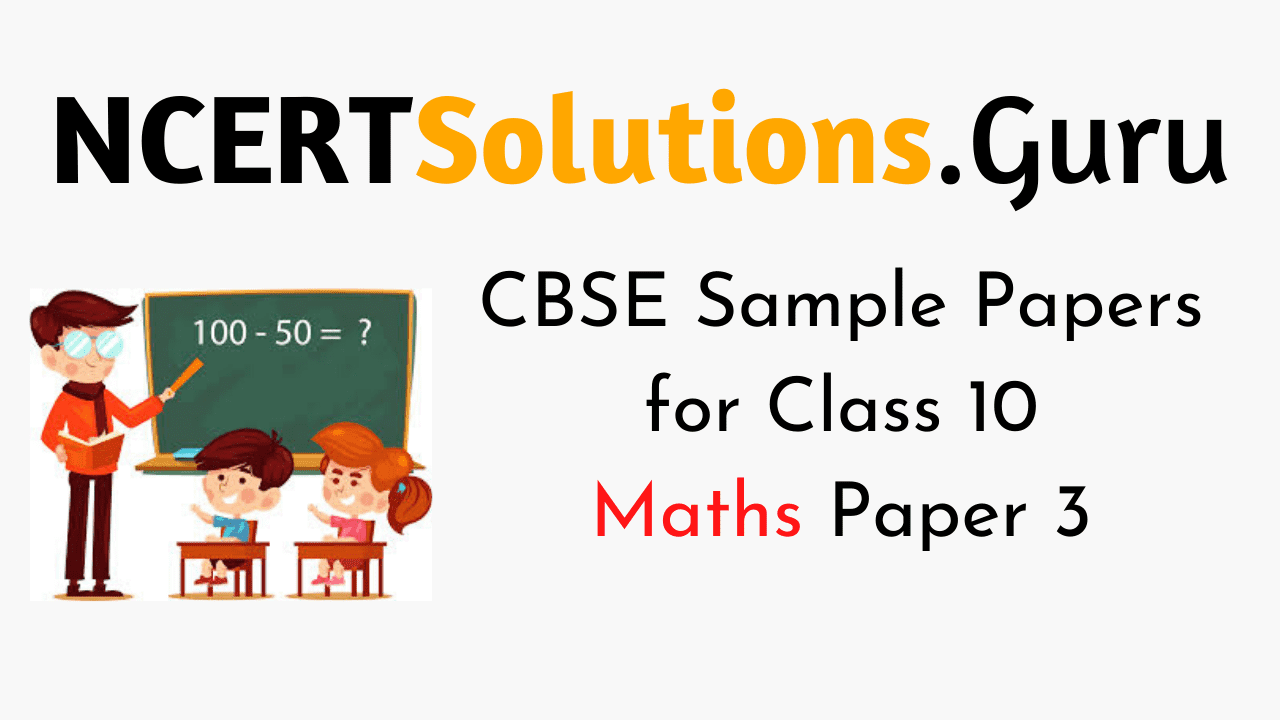CBSE Sample Papers for Class 10 Maths Paper 3
These Sample papers are part of CBSE Sample Papers for Class 10 Maths. Here we have given CBSE Sample Papers for Class 10 Maths Paper 3
Time Allowed : 3 hours
Maximum Marks : 80
General Instructions
- All questions are compulsory.
- The question paper consists of 30 questions divided into four sections — A, B, C and D.
- Section A contains 6 questions of 1 mark each. Section B contains 6 questions of 2 marks each. Section C contains 10 questions of 3 marks each. Section D contains 8 questions of 4 marks each.
- There is no overall choice. However, an internal choice has been provided in 4 questions of 3 marks each and 3 questions of 4 marks each. You have to attempt only one of the alternatives in all such questions.
- Use of calculator is not permitted.
SECTION-A
Question 1.
Vertices of a triangle are (- 4, 0), (4, 0), (0, 3). What type of triangle is it ? [1]
Question 2.
If two positive integers p and q can be expressed as p = ab2 and q = a2b; a, b being prime
numbers, then find LCM (p, q). [1]
Question 3.
D and E are respectively the points on the sides AB and AC of a triangle ABC such that
AD = 2 cm, BD = 4 cm, BC = 9 cm and DE || BC. Then, find the length of DE. [1]
Question 4.
Find a quadratic polynomial, the sum and product of whose zeroes are 3 and – 2 respectively. [1]
Question 5.
For what value of p are 2p + 1, 12, 5p – 3 are three consecutive terms of an A.P. ? [1]
Question 6.

SECTION-B
Question 7.
The decimal expansion of the rational number \(\frac { 33 }{ { 2 }^{ 2 }.{ 5 }^{ n } } \) terminates after 3 places of decimal. Then find the value of n. [2]
Question 8.
Find the value of a, if the distance between the points A(- 3, – 14) and B(a, – 5) is 9 units [2]
Question 9.
17 cards numbered 1, 2, 3, …, 17 are put in a box and mixed thoroughly. One person draws a card from the box. Find the probability that the number on the card is : [2]
- Odd
- A prime
- Divisible by 3
- Divisible by 3 and 2 bot
Question 10.
What is the probability that an ordinary year has 53 Sundays. [2]
Question 11.
Determine the sum of first 100 odd natural number. [2]
Question 12.
Find the zeroes of the polynomial 2x2 + x – 6. [2]
SECTION-C
Question 13.
Find the largest number that divides 1251, 9377 and 15628 leaving remainders 1, 2 and 3 respectively. [3]
Question 14.
The points A(2, 9), B(a, 5) and C(5, 5) are the vertices of a triangle ABC right angled at B. Find the values of a and hence the area of ∆ABC. [3]
OR
A(6,1), B(8, 2) and C(9, 4) are three vertices of a parallelogram ∆BCD. If E is the mid-point of DC, find the area of ∆ADE.
Question 15.
Prove that the sum of the squares of the sides of a rhombus is equal to the sum of the squares of its diagonals. [3]
OR
If BL and CM are median of a triangle ABC right angled at A then prove that:
4(BL2 + CM2) = 5BC2.
Question 16.
Prove that the angle between the two tangents drawn from an external point to a circle is supplementary to the angle subtended by the line segment joining the points of contact at the centre. [3]
Question 17.
From a circular piece of cardboard of radius 3 cm, two sectors of 90° have been cut off. Find the perimeter of the remaining portion to nearest hundredth centimetres. (Take π = \(\frac { 22 }{ 7 } \)) [3]
OR
Find the area of the segment of a circle of radius 12 cm whose corresponding sector has a central angle of 60°.
(Use π = 3.14)
Question 18.
Water is flowing at the rate of 15 km/h through a pipe of diameter 14 cm into a cuboidal pond which is 50 m long and 44m wide. In what time will the level of water in pond
rise by 21 cm ? [3]
OR
How many spherical lead shots each of diameter 4.2 cm can be obtained from a solid rectangular lead piece with dimensions 66 cm, 42 cm and 21 cm.
Question 19.
Find the zeroes of the polynomial 4x2 – x – 3 and verify the relationship between the zeroes and the coefficients. [3]
Question 20.
Solve graphically : 4x + 6y = 9; 7x + 5y = 2. [3]
OR
Sum of a two-digit number and the number formed by reversing the order of digits is 88. If difference of digits is 2 and the unit digit is greater, determine the number.
Question 21.
If sec θ = x + \(\frac { 1 }{ 4x } \), prove that : sec θ + tan θ = 2x or \(\frac { 1 }{ 2x } \) [3]
Question 22.
Find the mean of the following data : [3]
| Age | No. of females |
| Less than 10 | 7 |
| Less than 20 | 20 |
| Less than 30 | 45 |
| Less than 40 | 58 |
| Less than 50 | 71 |
SECTION-D
Question 23.
If the angle of elevation of a cloud from a point h metre above a lake is α and the angle of depression of its reflection in the lake is β, prove that the distance of the cloud from the point of observation is [4]

OR
A man is standing on the deck of a ship, which is 8 m above water level. He observes the angle of elevation of the top of a hill as 60° and the angle of depression of the base of the hill as 30°. Calculate the distance of the hill from the ship and the height of the hill.
Question 24.
Draw a line segment AB of length 8 cm. Taking A as centre, draw a circle of radius 4 cm and taking B as centre, draw another circle of radius 3 cm. Construct tangents of each circle from the centre of the other circle. [4]
Question 25.
Show that the tangent at any point of a circle is perpendicular to the radius through the point of contact. In the given figure, AT is a tangent to the circle with centre O such that OT = 4 cm and ∠OTA = 30°. Find the length of AT. [4]

Question 26.
A solid right circular cone of height 120 cm and radius 60 cm is placed in a right circular cylinder full of water of height 180 cm such that it touches the bottom. Find the volume of water left in the cylinder, if the radius of the cylinder is equal to the radius of the cone. [4]
OR
A well of diameter 3 m is dug 14 m deep. The earth taken out of it has been spread evenly all around it in the shape of a circular ring of width 4 m to form an embankment. Find the height of the embankment.
Question 27.
A boat can go 24 km downstream and return in 5 hours. If the speed of the stream is 2 km/hr, find the speed of the boat in still water. [4]
OR
Product of digits of a two-digit number is 14. When 45 is added to the number then the digits interchanged their places. Find the number.
Question 28.
Shalini gets pocket money from her father every day. Out of the pocket money, she saves ₹30 on the first day and on each succeeding day, she increases her savings by 500 paise. [4]
- Find the amount saved by Shalini on 10th day.
- Find the total amount saved by Shalini in 30 days.
Question 29.

Question 30.
Draw “more than ogive” for the following data : [4]
| Classes | Frequency |
| 1-10 | 2 |
| 11-20 | 12 |
| 21-30 | 38 |
| 31-40 | 24 |
| 41-50 | 10 |
SOLUTIONS
SECTION-A
Answer 1.
Given vertices of triangle are A(- 4, 0), B(4, 0) and C(0, 3).
We know that distance formula is,

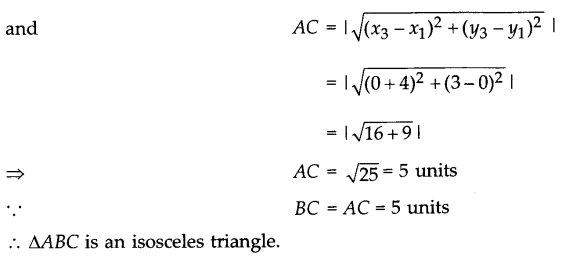
Answer 2.
We have, p = ab2 and q = a2b
Now, p = a × b × b
and q = a × a × b
∴ H.C.F. (p,q) = ab
We know,
Product of two numbers = H.C.F × L.C.M

Answer 3.
Given : AD = 2 cm, BD = 4 cm, BC = 9 cm
and DE || BC
In ΔABC and ΔADE,
DE || BC
∴ ∠B = ∠D [Corresponding angles]
and ∠C = ∠E [Corresponding angles]
∴ By AA similarly axiom
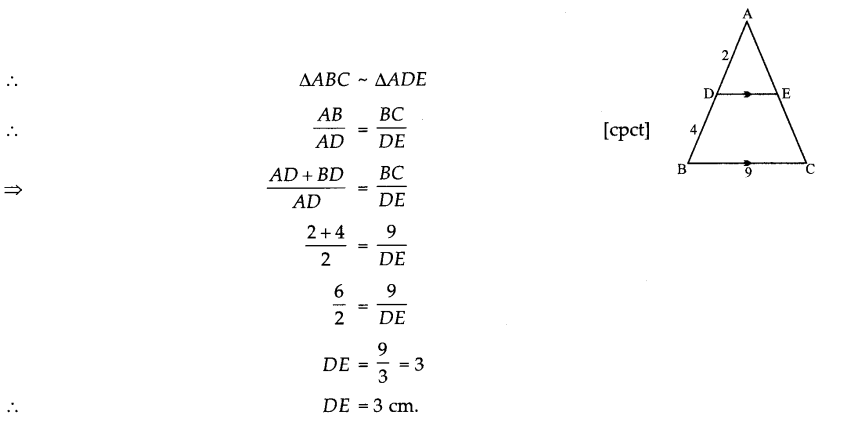
Answer 4.
Given : Sum of zeroes = 3 and Product of zeroes = – 2
We know that, equation of quadratic polyomial is given as
= k[x2 – (Sum of zeroes)x + Product of zeroes]
= k[x2 – 3x – 2] where k ≠ 0.
Answer 5.
Given : 2p + 1, 12, 5p – 3 are three consecutive terms of A.P.
12 – (2p + 1) = (5p – 3) – 12
12 – 2p – 1 = 5p – 3 – 12
11 – 2p = 5 p – 15
-2p – 5p = -15 – 11
– 7p = – 26
p = \(\frac { 26 }{ 7 } \).
Answer 6.
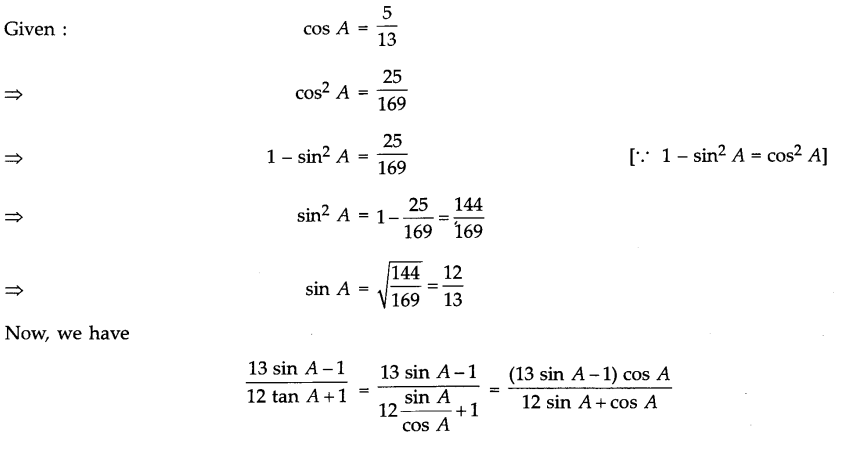
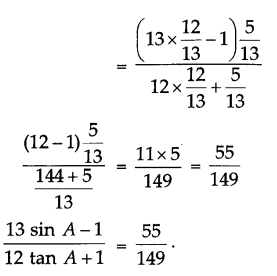
SECTION-B
Answer 7.
Given : Decimal expansion of rational number \frac { 33 }{ { 2 }^{ 2 }.{ 5 }^{ n } } terminate after 3 decimals.
∴ Denominator of decimal number will be in the form = (2 x 5)n and n = 3 to terminate after 3 decimals.
Answer 8.
Given : A(- 3, – 14), B(a, – 5) and AB = 9 units
By distance formula,

On squaring both sides, we get
81 = (a + 3)2 + (9)2
81 – 81 = (a + 3)2
⇒ (a + 3)2 = 0
On taking square root both side, we get
a + 3 = 0
a = – 3.
Answer 9.
Total number of cards = 1, 2, 3, …, 17.
n(S) = 17
(i) Probability that the number is odd.
Number of odd number cards = 1, 3, 5, 7, 9, 11, 13, 15, 17.
∴ n(E) = 9
Probability that number on the card is odd,
P(E) = \(\frac { n(E) }{ n(S) } \)
P(E) = \(\frac { 9 }{ 17 } \).
(ii) Probability that the number is a prime.
Number of prime number cards = 2, 3, 5, 7, 11, 13, 17
∴ n(E) =7
Probability that a card is prime number,
n(E) = \(\frac { n(E) }{ n(S) } \) = \(\frac { 7 }{ 17 } \)
(iii) Probability that the number is divisible by 3.
Number of cards divisible by 3 = 3, 6, 9, 12, 15
∴ n(E) = 5
Probability that the number is divisible by 3,
P(E) = \(\frac { n(E) }{ n(S) } \) = \(\frac { 5 }{ 17 } \)
(iv) Probability the number is divisible by 3 and 2 both.
Number of cards are divisible by 3 and 2 both = Number of cards are divisible by 6 = 6,12
∴ n(E) = 2
Probability that the number is divisible by 3 and 2 both,
P(E) = \(\frac { n(E) }{ n(S) } \) = \(\frac { 2 }{ 17 } \)
Answer 10.
1 year has 365 days = (52 x 7 + 1) days
Ordinary year has 52 Sunday + 1 day
1 day may be {Sun, Mon, Tue, Wed, Thu, Fri, Sat}
n(S) = 7
That 1 day may be Sun = {Sun}
∴ n(E) = 1
Probability of 53 Sundays in ordinary year
P(E) = \(\frac { n(E) }{ n(S) } =\frac { 1 }{ 7 } \)
Answer 11.
Sum of first 100 odd natural numbers i.e.,
1 + 3 + 5 + 7 + 9+ …
These are in arithmetic progression, with
a = 1, d = 3 – 1 = 2, n = 100
We know that

Answer 12.
Given polynomial is,
2x2 + x – 6 = 0
2x2 + 3x – 3x – 6 = 0
2x(x + 2) – 3(x + 2) = 0
(x + 2) (2x – 3) = 0
Either x + 2 = 0 ⇒ x = -2 or 2x – 3 = 0 ⇒ x = \(\frac { 3 }{ 2 }\)
∴ Zeroes of the polynomial are – 2 and \(\frac { 3 }{ 2 }\)
SECTION-C
Answer 13.
Given : 1251, 9377 and 15628 leave remainders 1, 2 and 3 respectively.
Required number = H.C.F. of (1251 – 1), (9377 – 2) and (15628 – 3)
= H.C.F. of 1250, 9375 and 15625
By Euclid’s lemma,
15625 = 1 x 9375 + 6250
9375 = 1 x 6250 + 3125
6250 = 2 x 3125 + 0
∴ H.C.F. of 15625 and 9375 = 3125.
and H.C.F. of 3125 and 1250 = 625.
Again by Euclid’s lemma
3125 = 2 x 1250 + 625
1250 = 2 x 625 + 0
∴ H.C.F. of 1250, 9375 and 15625 = 625
Hence, 625 is largest number that divides 1251, 9377 and 15628 leaving remainders 1, 2 and 3 respectively.
Answer 14.
Given : Vertices of triangle are A(2, 9), B(a, 5) and C(5, 5).
By distance formula,



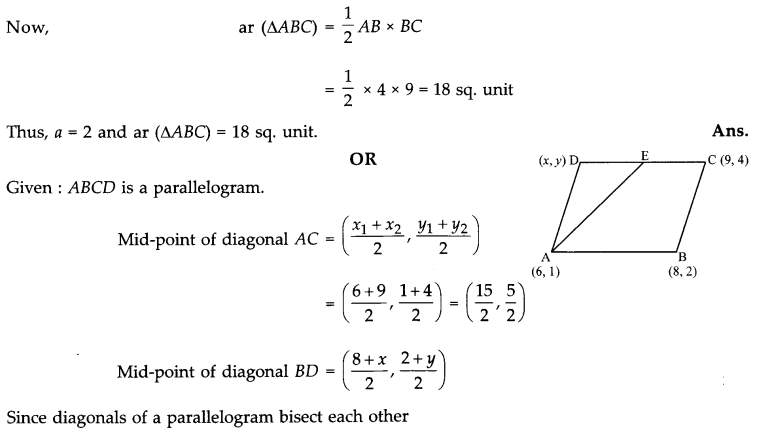

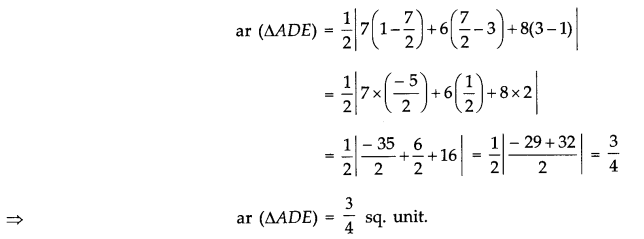
Answer 15.
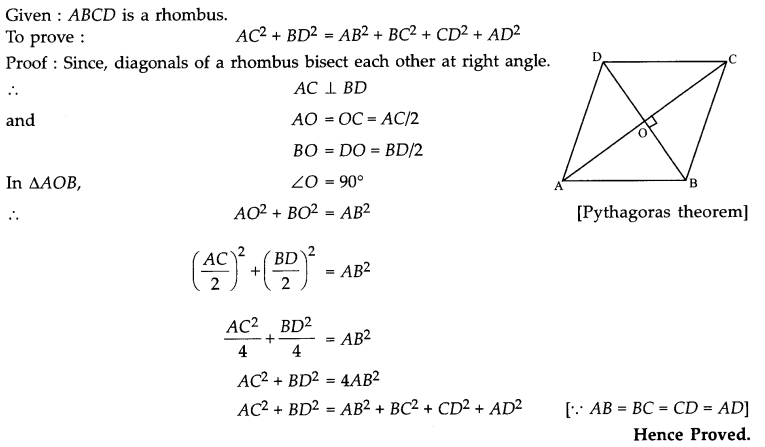
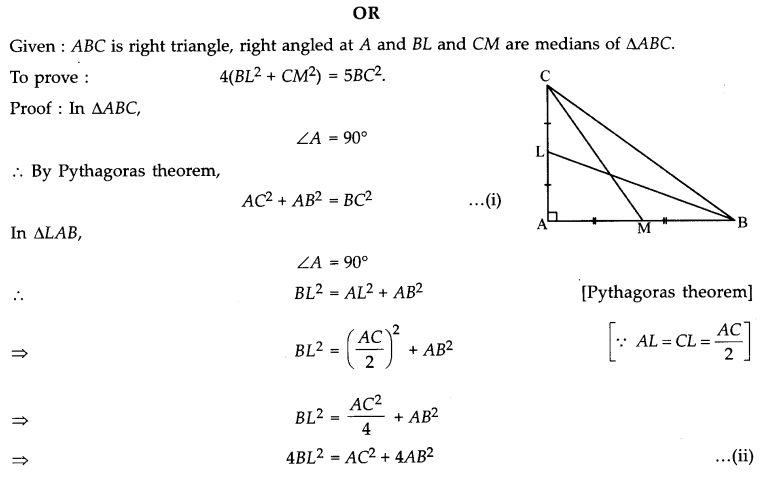
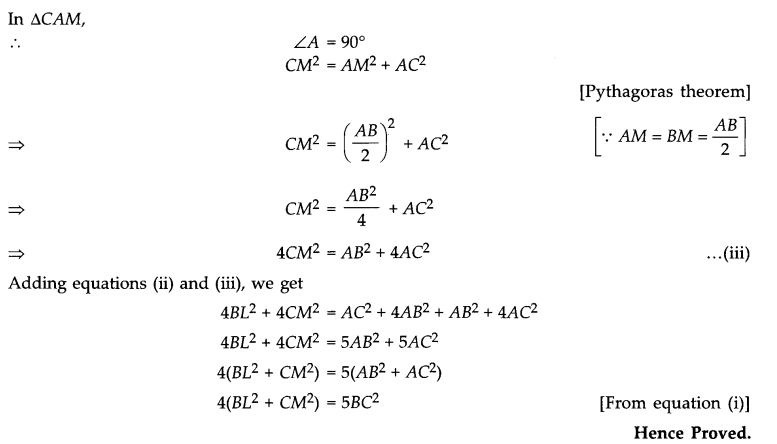
Answer 16.
Given : PA and PB are tangents to a circle having centre O.
To prove : ∠AOB + ∠APB = 180°.

Proof : OA is the radius of circle and PA is the tangent to the circle.
∴ ∠OAP = 90° …(i)
Similarly, OB is the radius of circle and PB is the tangent to the circle.
∴ ∠OBP = 90°
In quadrilateral APBO,
∠OAP + ∠APB + ∠PBO + ∠BOA = 360°
90° + ∠APB + 90° + ∠BOA = 360°
∠APB + ∠BOA = 360° – 180°
∠APB + ∠BOA = 180°.
Answer 17.
We have, radius of cardboard, r = 3 cm.
Two sectors AOB and COD have been cut off in the circular cardboard.
∴ Perimeter of remaining cardboard = OA + length of arc APD + OD + OB + Length of arc BQC + OC
= r + Length of arc APD + r + r + Length of arc BQC + r
= 4 x r + length of arc APD + length of arc BQC
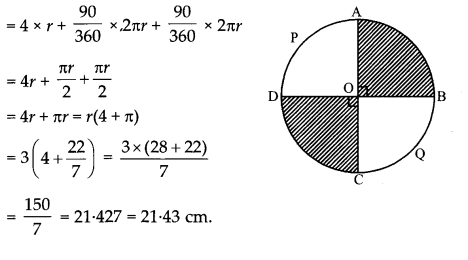 |
|
OR
Given : Radius of circle, r =12 cm
Central angle of segment = 60°
Area of segment = Area of sector OACD – Area of ∆AOB

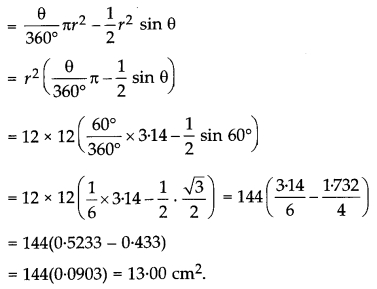
Answer 18.
Given : Diameter of cylindrical pipe = 14 cm
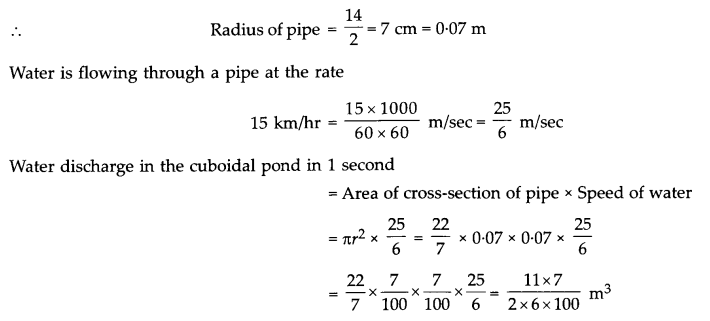
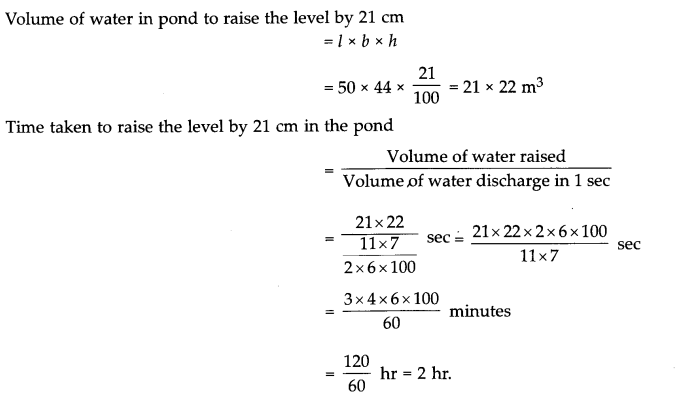
OR
Given : Diameter of lead ball = 4.2 cm
∴ Radius, r = \(\frac { 4.2 }{ 2 }\) = 2.1 cm
Dimensions of lead piece = 66 cm × 42 cm × 21 cm
Volume of rectangular lead piece = l × b × h = 66 × 42 × 21 cm3
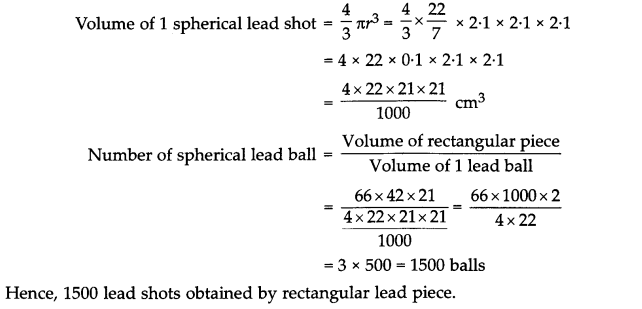
Answer 19.
Given polynomial is
4x2 – x – 3 = 0
⇒ 4x2 – 4x + 3x – 3 =0
⇒ 4x(x – 1) + 3(x – 1) =0
⇒ (x – 1) (4x + 3) = 0
Either x – 1 = 0 ⇒ x = 1 or x + 3 = 0 ⇒ x = – \(\frac { 1 }{ 4 }\)
∴ Zeroes of the polynomial are 1 and – \(\frac { 3 }{ 4 }\)
Now,

Answer 20.
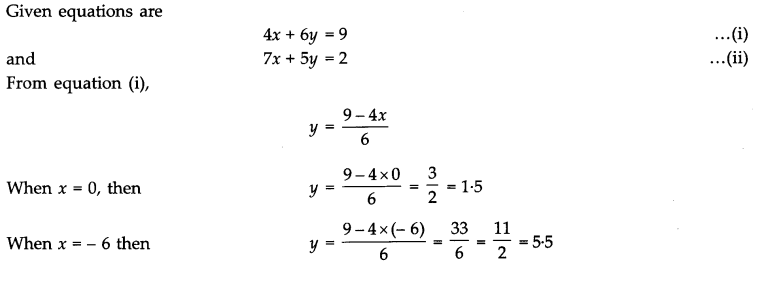
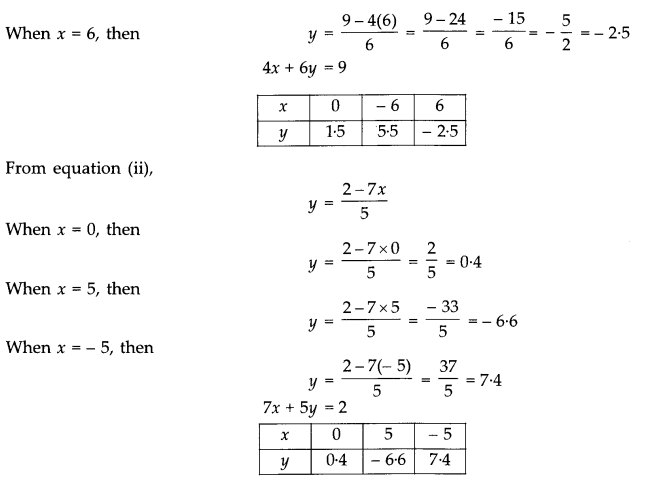

The point of intersection of these lines is (- 1.5, 2.5).
∴ x = -1.5 and y = 2.5
OR
Let the ten’s place of digit be x.
Therefore, unit place of digit will be (x + 2)
Two-digit number = 10 × x + (x + 2) = 11x + 2
Reverse of the number = 10(x + 2) + x = 11x + 20
According to the question,
11x + 2 + 11x + 20 = 88
22x = 88 – 22
x = \(\frac { 66 }{ 22 }\) = 3
∴ Two-digit number = 11x + 2 = 11 × 3 + 2 = 35.
Answer 21.
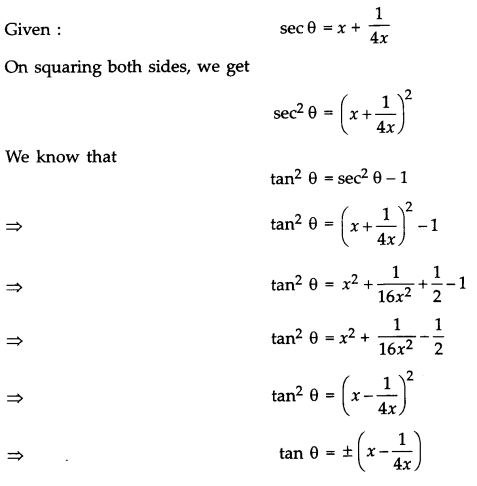
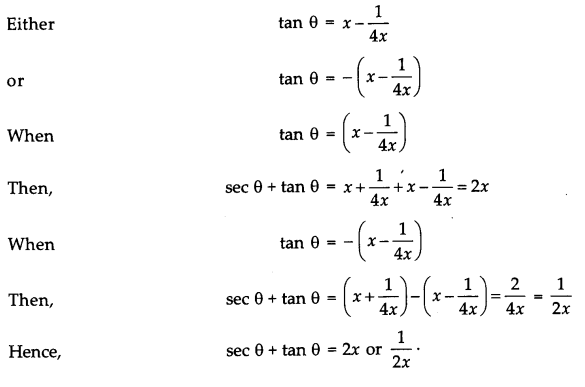
Answer 22.
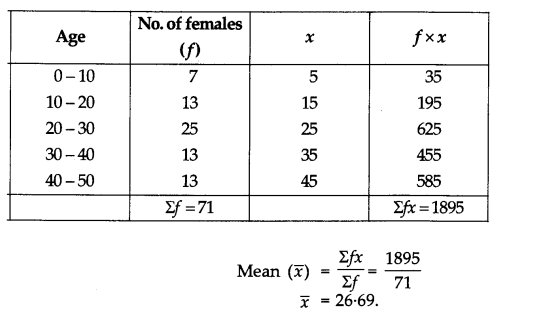
SECTION-D
Answer 23.
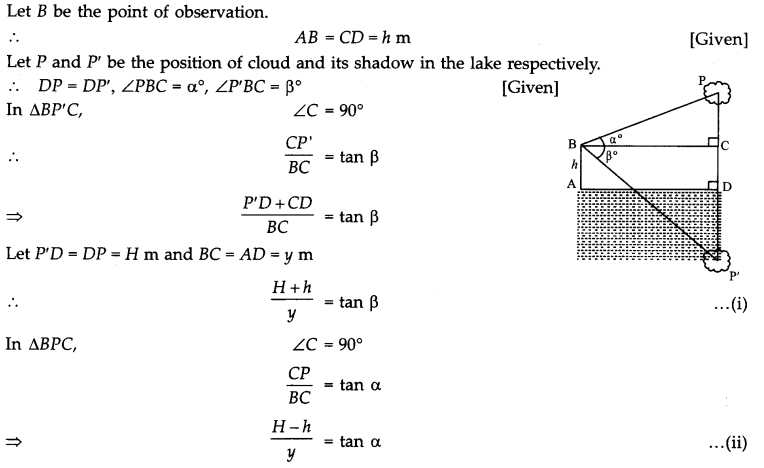

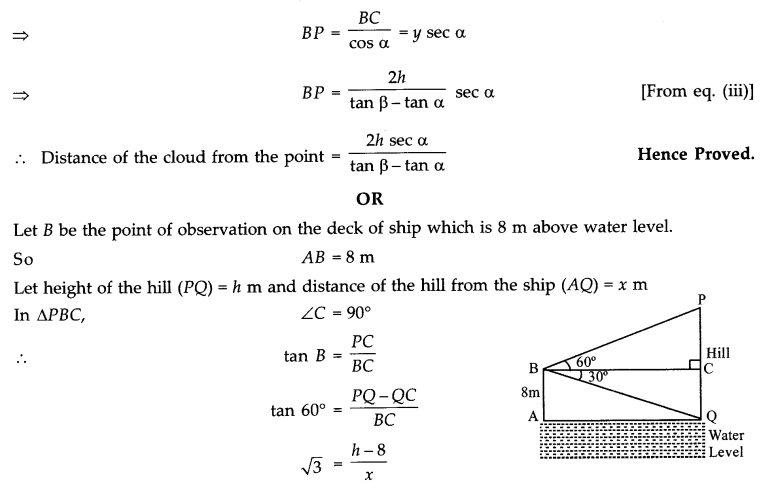

Putting the value of x in equation (i), we get
h = 8 + √3 . 8√3
h = 8 + 24 = 32 m
and x = 8 × 1.732 = 13.856 m
Thus, height of the hill = 32 m
and distance between hill and ship = 13.856 m.
Answer 24.
Steps of construction :
- Draw a line segment AB = 8 cm.
- With A as centre and radius 4 cm, draw a circle.
- With B as centre and radius 3 cm, draw another circle.
- Draw perpendicular bisector of AB which meets AB at M.
- With M as centre and MA as radius, draw a circle intersecting the circle with centre A at P and Q and the circle with centre B at R and S.
- Join AR, AS, BP, BQ which are the required tangents.
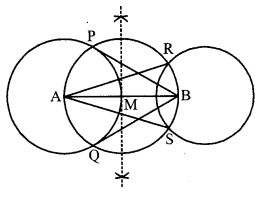
Answer 25.
Given : A circle C(0, r) and a tangent l at point A.
To prove : OA ⊥ l.
Construction : Take a point B, other than A, on the tangent l. Join OB. Suppose OB meets the circle at C.

Proof : We know that, among all line segment joining the point O to a point on l, the perpendicular is shortest to l.
Clearly, OA = OC
Now, OB = OC + BC
∴ OB > OC
⇒ OB > OA
⇒ OA < OB
Thus, OA is shortest than any other line segment joining O to any point on l.
Thus, OA ⊥ l.
Given : OT = 4 cm
∠OTA = 30°
Construction : Join OA.
Now, OA is the radius of circle and AT is the tangent to the circle.
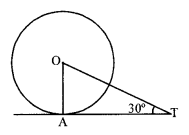
∴ OA ⊥ AT
In ΔOAT, ∠A = 90°
∴ cos T = \(\frac { AT }{ OT } \)
cos 30° = \(\frac { AT }{ 4 } \)
\(\frac { \sqrt { 3 } }{ 2 } \) = \(\frac { AT }{ 4 } \)
∴ AT = 2√3 = 2 × 1.732 = 3.464 cm
Answer 26.
Given :
Radius of cylinder = Radius of cone = r = 60 cm
Height of cylinder (h) =180 cm
and Height of cone (H) =120 cm
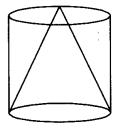
Now,
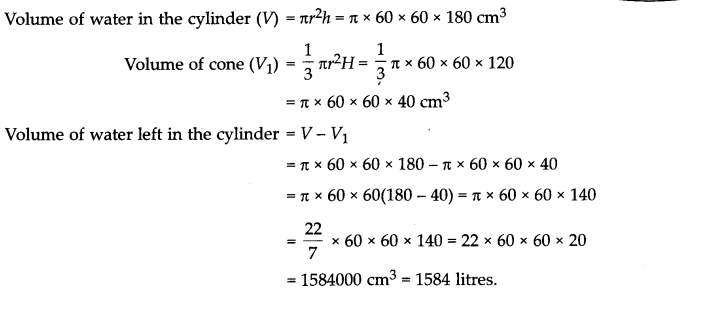
OR
Given :
Diameter of well = 3 m
∴ Radius, r = \(\frac { 3 }{ 2 } \)
Depth of well, h = 14 m
and Width of embankment = 4 m
Volume of sand dug out = πr²h
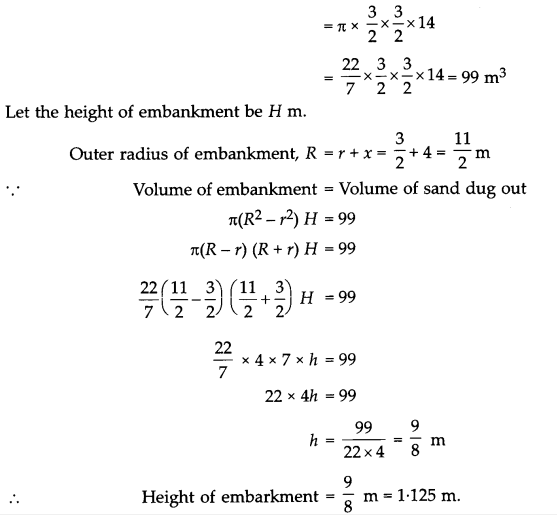
Answer 27.
Given : Speed of stream = 2 Km/h
Let the speed of the boat in still water = x km/hr
∴ Speed of boat in downstream = (x + 2) km/hr
and speed of boat in upstream = (x – 2) Km/hr
We know
Time = \(\frac { Distance }{ Speed } \)
∴ Time taken to go 24 Km Up stream = \(\frac { 24 }{ x-2 } \)
and time taken to go 24 Km downstream = \(\frac { 24 }{ x+2 } \)
According to the question,

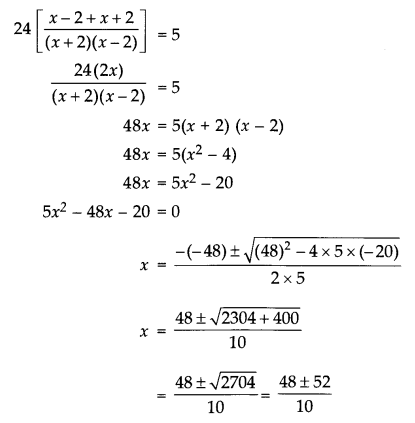

OR
Let the unit digit be x and tens digit be y
Number = 10y + x
and, reverse of the number = 10x + y
According to the question,
xy = 14
and, 10y + x + 45 = 10x + y
⇒ 9x – 9y = 45
⇒ x-y =5
⇒ x = 5 + y
Substituting the value of x in equation (i), we get
(5 + y)y = 14
y2 + 5y – 14 = 0
y2 + 7y – 2y – 14 = 0
y(y + 7)-2(y + 7) =0
(y + 7) (y-2) =0
y + 7 = 0 ⇒ y = – 7 (digit is not negative)
y – 2 = 0 ⇒ y = 2
x =5 + y = 7
When y = 2, then
∴ Required two-digit number = 10y + x = 10 × 2 + 7 = 27
Answer 28.
Money saved on 1st day = ₹ 30
Money saved on IInd day = ₹ 30 + 500 p = ₹ 35
Money saved on IIIrd day = ₹ 30 + 500 p + 500 p = ₹ 35
and so on.
Amount of money saved on successive days is an AP with
First term, a = 30 and common difference, d = 5.
(i) Money saved on 10th day,
We know that
∴ an = a + (n – 1 )d
a10 = a + 9d = 30 + 9 x 5 = ₹ 75
(ii) Money saved in 30 days

Answer 29.
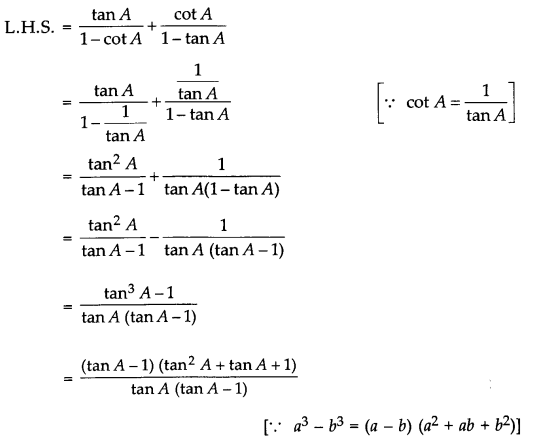
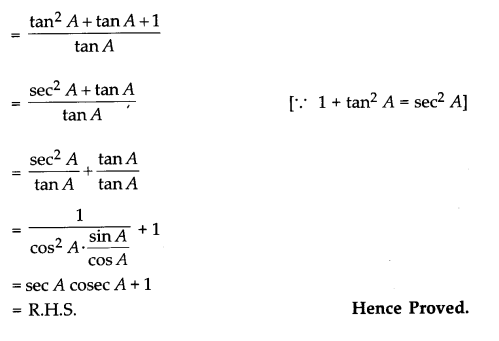
Answer 30.

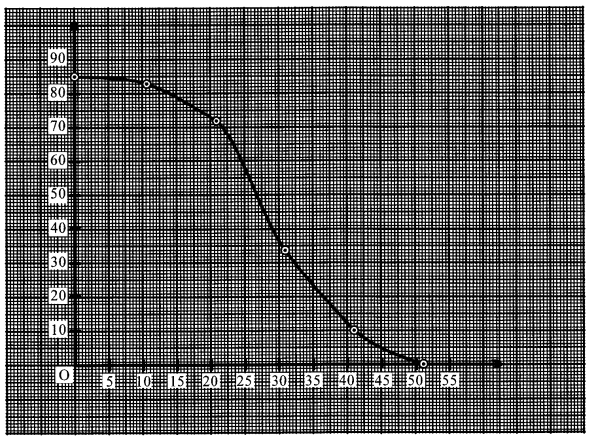
We hope the CBSE Sample Papers for Class 10 Maths Paper 3 help you. If you have any query regarding CBSE Sample Papers for Class 10 Maths Paper 3, drop a comment below and we will get back to you at the earliest.
